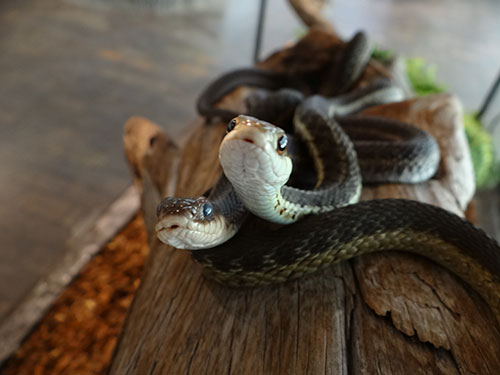Program Highlights
This exciting grade 6 program provides students with a unique opportunity to explore the classification of living things through “hands-on, minds-on” experiences with live animals and real animal specimens. Created specifically to meet curriculum outcomes in the grade 6 science unit on the diversity of life, this program uses an object-based and skills-based approach to encourage students to develop their classification and observation skills.
Touch the jaw of a shark! Observe the wet skin of a bull frog! Through multisensory observation, discussion, asking questions, and recording their observations, students will explore Nova Scotian animals representing different animal groups: mammals, birds, reptiles, amphibians, fish, and invertebrates. In a concluding activity, students will be challenged as a group to construct classification charts to compare the characteristics of these animals.
Curriculum Outcome Links
Specific Curriculum Outcomes
- Create and analyze their own chart or diagram for classifying and describe the role of a common classification system (300-15)
- Classify animals as vertebrates or invertebrates and compare the characteristics of mammals, birds, reptiles, amphibians, and fishes (300-16, 300-17)
Science Skills
- Classify according to several attributes and create a chart or diagram that shows the method of classifying (206-1)
- Communicate questions, ideas, and intentions, and listen to others while conducting investigations (207-1)
Program Length
90 min
Program Capacity
- 2 classes (60 students maximum)
- 1 chaperone for every 5 students
Cost
The charge for this program is $3.55 per student which includes the tax. The teachers are admitted free of charge. One chaperone is admitted free for every five students (1:5 ratio).
Activities
10 minutes: Introduction
The program begins with an introduction to classification and the scientific language of classification through an interactive activity.
60 minutes: Gallery Stations
In small groups, students will visit seven animal exhibits around the Museum representing different animal groups: mammals, birds, reptiles, amphibians, fish, and invertebrates (arthropods and echinoderms). At each exhibit, students will observe the animals and related specimens through multiple senses. Students will record their observations through writing and/or drawing in field notebooks.
20 minutes: Conclusion
In a concluding activity, students will be challenged as a group to use their observations to classify the animals they have observed into groups. A t-chart will be used for the students to create a dichotomous classification chart to compare and classify the animals based on several different characteristics.
Information and Reservations
To book this program for select dates in October, November and December 202
5, please email
